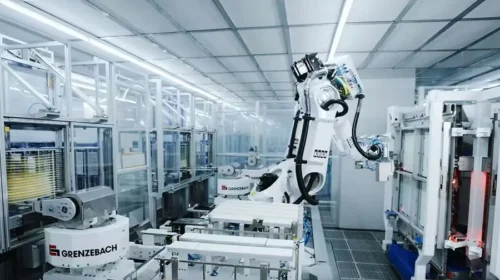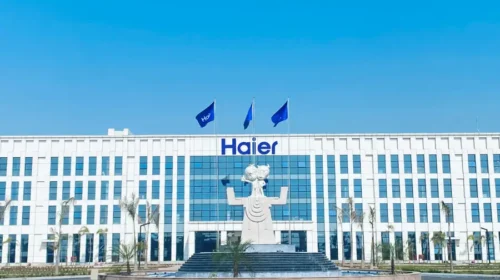Tianyu Semiconductor seeks IPO cash infusion in turbulent market

The maker of silicon carbon (SiC) wafers used to make automotive chips said its revenue contracted in the first half of this year after two years of explosive growth
Key Takeaways:
- Guangdong Tianyu Semiconductor has applied to list in Hong Kong, aiming to replenish its cash reserves that are running dangerously low
- The wafer maker’s revenue contracted in the first half of this year, but it says it’s turning things around with several major new purchasing commitments
By Doug Young
One might call it the “Tale of Two Wafer Makers.”
The first of that pair, InnoScience (Suzhou) Technology Holding Co. Ltd. (2577.HK), made its Hong Kong trading debut on Monday with a slight gain from its listing price of HK$30.86. The second, Guangdong Tianyu Semiconductor Co. Ltd. is hoping to do even better with its own Hong Kong IPO listing plan disclosed last week.
These two companies are quite similar in several ways. Both produce silicon wafers used to make microchips, mostly for the car industry. Both are also focused on producing 8-inch wafers, considered one of the most cutting-edge products from their group. The two companies’ sizes are also remarkably similar, with InnoScience reporting 386 million yuan ($52.9 million) in revenue during the first half of 2024, to 361 million yuan for Tianyu.
Last but not least, these two companies stand out for their similar decisions to list in Hong Kong. That’s somewhat unusual for Chinese chip companies, which have mostly gravitated to China’s domestic A-share markets in Shenzhen and Shanghai, where they receive strong support from domestic investors eager to help the country develop the sector. This recent move to Hong Kong could reflect broader caution by China’s securities regulator as it reins in new listings to support the market in the face of weak sentiment.
Similarities aside, there are also some key differences to these two new listings. InnoScience uses a less mature technology in its wafers called gallium nitride (GaN), whereas Tianyu uses the more mature silicon carbon (SiC) technology, specifically producing SiC epitaxial wafers.
But perhaps most importantly for investors, these two companies differ on how their business is trending. While InnoScience recorded 25% year-on-year revenue growth in the first half of 2024, Tianyu’s revenue fell by about 15% over that period, reversing triple-digit growth in the previous two years. Making matters worse, Tianyu’s sudden reversal also thrust the company into the red after two profitable years, putting it in the same money-losing league as InnoScience.
So, what’s behind the two very different trajectories of these otherwise very similar-looking companies? The answer may lie partly in their different technologies. Tianyu operates in a more competitive sector for SiC wafers, whereas InnoScience’s GaN sector is still emerging and is thus a little less crowded.
The pair also operate in a very volatile sector where many of their largest customers make chips for use in new energy vehicles (NEVs). In fact, three of Tianyu’s investors are quite active in the NEV space, namely BYD (1211.HK; 002594.SZ), Huawei and SAIC (600104.SH). In such a fast-changing environment, it’s not uncommon to see big swings in your business from year to year, since some big NEV makers today could easily become yesterday’s news tomorrow.
This reality is most evident in the “customer concentration” section of Tianyu’s listing document, which appears to show heavy customer turnover in the last two years. The company said its top five customers accounted for 91.4% of its revenue in the first half of this year, up sharply from 77.2% in all of 2023, implying it lost a lot of smaller customers over the last year. What’s more, its largest customer accounted for a majority 52.6% of its revenue in the first half of 2024, up from 42% last year and just 21% in 2022.
Revenue reversal
Next, we’ll take a closer look at Tianyu’s rapid rise and recent stumble, as well as what the company is doing to try to reverse course and return to growth. Most of the company’s current output is 6-inch wafers, though it’s trying to move into more advanced 8-inch wafers that generally sell for higher prices due to their higher microchip yields.
Tianyu’s wafer shipments soared from around 17,000 in 2021 to just over 132,000 last year, growing at an annual rate of around 178.7%. The vast majority of its output is still 6-inch wafers, which accounted for 98% of its output last year and in the first half of 2024. But the company notably produced its first large batch of 8-inch wafers in the first half of this year, totaling 320 wafers. It says it now has the ability to mass produce such wafers, which should help to improve its performance as that business becomes a larger part of its revenue mix.
Tianyu’s revenue also grew explosively from 154.6 million yuan in 2021 to 1.17 billion yuan last year, equal to 175% annual growth.
But then the company hit a major speed bump this year. It sold 46,547 wafers in the first half of 2024, down by a relatively small 3% from 48,020 a year earlier. But its revenue fell by a larger 14.8% over that period to 361 million yuan from 424 million yuan. That discrepancy implies a big drop in prices, and, indeed, Tianyu blames the drop on “a decrease in selling prices of SiC epitaxial wafers as we strategically reduced our selling prices to improve market penetration.”
The lower prices, combined with an increase in inventory write-downs, weighed on the company’s profitability. After rising steadily from 15.7% in 2021 to 19.4% in 2023, Tianyu’s gross margin abruptly fell into negative territory at negative 12.1% in the first half of this year. As a result, it reported a 141 million yuan net loss in the first half of 2024 compared with a 20.7 million yuan profit a year earlier.
The company said it remains cash flow positive, though its actual cash is dropping quite rapidly. That amount stood at just 84 million yuan at the end of June this year, down sharply from 268 million yuan a year earlier.
To right its ship, Tianyu said it has entered into several long-term agreements to supply more than 450,000 wafers over the next three years, 40% of those 8-inch wafers. Such commitments look quite significant, averaging 150,000 wafers per year, which is already higher than the 132,000 wafers the company sold in 2023.
While such commitments look generally positive, there’s always the danger that the companies behind those commitments may change their minds later, especially with such volatility in the NEV market. There’s not much that Tianyu can do to change that reality, and it’s undoubtedly hoping investors will believe in those commitments and buy into its IPO story by giving it more cash to keep the company running.
To subscribe to Bamboo Works weekly free newsletter, click here





